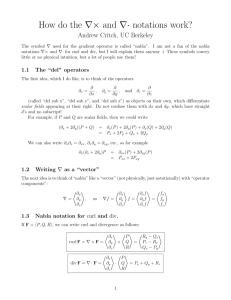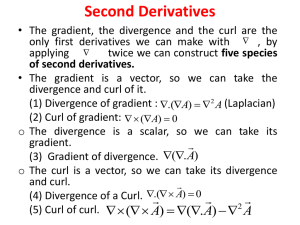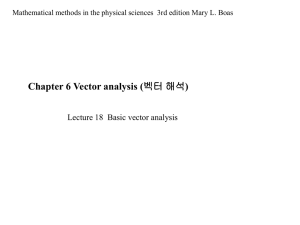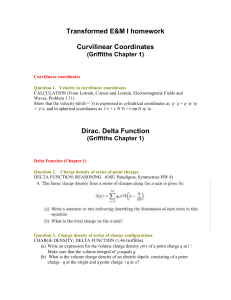Helmholtz Theorem
advertisement
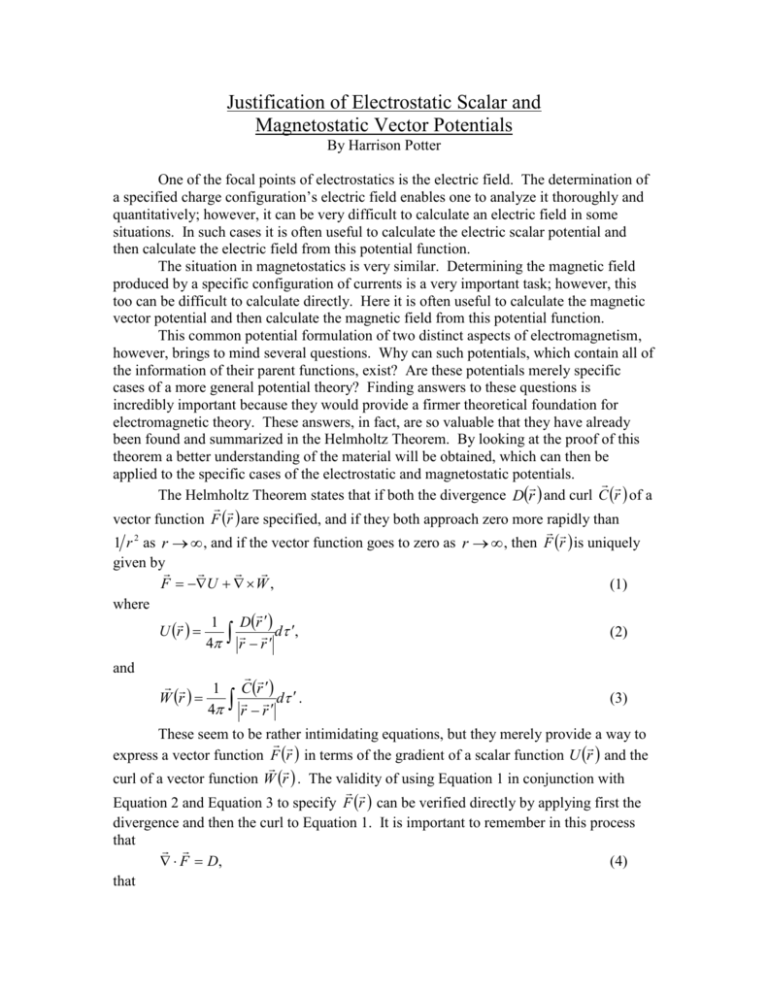
Justification of Electrostatic Scalar and Magnetostatic Vector Potentials By Harrison Potter One of the focal points of electrostatics is the electric field. The determination of a specified charge configuration’s electric field enables one to analyze it thoroughly and quantitatively; however, it can be very difficult to calculate an electric field in some situations. In such cases it is often useful to calculate the electric scalar potential and then calculate the electric field from this potential function. The situation in magnetostatics is very similar. Determining the magnetic field produced by a specific configuration of currents is a very important task; however, this too can be difficult to calculate directly. Here it is often useful to calculate the magnetic vector potential and then calculate the magnetic field from this potential function. This common potential formulation of two distinct aspects of electromagnetism, however, brings to mind several questions. Why can such potentials, which contain all of the information of their parent functions, exist? Are these potentials merely specific cases of a more general potential theory? Finding answers to these questions is incredibly important because they would provide a firmer theoretical foundation for electromagnetic theory. These answers, in fact, are so valuable that they have already been found and summarized in the Helmholtz Theorem. By looking at the proof of this theorem a better understanding of the material will be obtained, which can then be applied to the specific cases of the electrostatic and magnetostatic potentials. The Helmholtz Theorem states that if both the divergence Dr and curl C r of a vector function F r are specified, and if they both approach zero more rapidly than 1 r 2 as r , and if the vector function goes to zero as r , then F r is uniquely given by F U W , (1) where 1 Dr U r (2) d , 4 r r and 1 W r 4 C r d . r r (3) These seem to be rather intimidating equations, but they merely provide a way to express a vector function F r in terms of the gradient of a scalar function U r and the curl of a vector function W r . The validity of using Equation 1 in conjunction with Equation 2 and Equation 3 to specify F r can be verified directly by applying first the divergence and then the curl to Equation 1. It is important to remember in this process that F D, (4) that F C, (5) and that since the divergence of a curl is always zero, (6) C 0. First the divergence of F r must be found. This is calculated to be F (U ) ( W ) 2U (7) because the divergence of a curl is always 0. If Equation 2 is now substituted in for U r , the divergence of F r can be found solely in terms of Dr . It is crucial to notice here that is operating only on r , not on r , so that Dr remains unaffected by . Thus, making use of the properties of the Dirac Delta function, the result is 2 1 1 1 ( )d D r Dr (4 3 r r )d Dr , (8) 4 4 r r so the divergence of F r truly is Dr , as must be the case if the representation of F r given by Equation 1 is to be valid. Computing the curl is slightly more involved. The process begins, however, just as before: by applying the curl to Equation 1. This yields F (U ) ( W ) ( W ) (9) because the curl of the gradient of any scalar function is 0. Using a product rule, this result can be expanded to yield 2W ( W ) . (10) At this point it is prudent to expand these 2 summands in terms of C r separately. The first summand yields 1 2 1 1 3 r C r ( ) d C r ( 4 r r ) d C 4 4 r r (11) because is again operating only on r , not on r , and the properties of the Dirac Delta again dictate the value of the integral. This result is exactly what is required, as long as ( W ) is 0. If this is the case, then the curl of F r truly is C r , as must be the case if the representation of F r given by Equation 1 is to be valid. Fortunately, this can be demonstrated by applying Equation 3 in order to calculate the divergence of 4 W r . This yields 1 1 4 ( W ) C r ( )d C r ( )d (12) r r r r because in this specific case the chain rule leads to the conclusion that 2 , (13) simply because of the nature of the functions upon which these operators are acting. By first applying a product rule, and then making use of Gauss’s Theorem on the second term, the equation 1 C r C r d ( )d r r r r 1 C r C r d da r r r r (14) can be obtained. The first term in Equation 13 is 0 as a direct result of Equation 6. The second term in Equation 13 is 0 so long as the surface integral is taken over all of space and the function C r goes to 0 quickly enough. This is justified intuitively by mentally expanding the surface over which the integration is taking place until it is unimaginably large. The curl C r on this distant surface of the function F r should go to 0 for realistic, finite situations; however, the area will be very large, increasing as r 2 . Thus if the curl C r goes to zero more rapidly than the rate at which the area gets larger, the second term is indeed 0 when the integration is done over all of space. Combining this result with that of Equation 11, it has been demonstrated that the curl of F r , as given by Equation 1, is indeed C r . The proof is not quite complete just yet, though: several details must be taken into consideration. The integrals given by Equation 2 and Equation 3, for example, must exist in order for the steps above to be valid. This translates into the specific requirement that both C r and Dr go to 0 faster than 1 r 2 as r , for if they went to 0 as 1 r 2 , then the integrals would have the general form Kdr , where K is a constant, which is a divergent integral. If they went to zero slower than 1 r 2 the corresponding integrals would be even more divergent. Another difficulty arises because of the fact that any vector function that has both 0 divergence and 0 curl could be added to the F r specified in Equation 1 without affecting its curl or divergence; thus, F r is not yet uniquely specified. This difficulty can be avoided, however, by requiring F r to approach 0 as r because it is a mathematical fact that no function that approaches 0 as r has 0 divergence and 0 curl everywhere; thus no function could be added to F r without disturbing its value at this limit. Since these specifications are included in the formal statement of the Helmholtz Thoerem, its proof is complete. Now that the Helmholtz Theorem has been proven, it is appropriate to apply it to some specific cases. Take the case where the curl of F r is 0, as in the electrostatic 3 case. In this case F r has only a scalar potential, as indeed is true for electrostatics, where E V , (15) and E , (16) 0 so that 1 r V (17) d . 4 0 r r Now consider the case where the divergence of F r is 0, as in the magnetostatic case. In this case F r has only a vector potential, as indeed is true for magnetostatics, where B A, (18) and (19) B 0 J , so that 0 J r (20) A d . 4 r r The above equations are an effective summary of the potentials of electrostatics and magnetostatics, and it can easily be seen how they follow from the Helmholtz Theorem by comparing equations 15 through 20 to equations 1 through 5. To further demonstrate that any vector function F r that has 0 divergence can be written as the curl of a vector function Ar , consider the following, independently of the Helmholtz Theorem. In order to find a vector potential Ar such that F r is the curl of Ar , the following equations must be satisfied. Az Ay (21) Fx y z Ax Az (22) Fy z x Ay Ax (23) Fz x y One way to do this is to set Ax equal to 0, and use this to solve equations 21 through 23 for Ay and Az . Following this course, it is found that A x y Ay Fz x, y, z dx C1 y, z (24) 0 and 4 x Az Az Fy x, y, z dx C2 y, z (25) 0 must both hold while satisfying Equation 21, in particular when x is 0, so taking C1 y, z to be 0, this determines the value of C2 y, z to be that for which equations 21 through 23 are all simultaneously satisfied, namely y Az Az 0, y, z Fx 0, y, z dy C2 y, z . (26) 0 Thus all that remains are the three equations Ax 0 , (27) x Ay Fz x, y, z dx , (28) 0 and y x 0 0 Az Fx 0, y , z dy Fy x, y, z dx. (29) Note that Ar certainly need not be solenoidal (have 0 divergence), but that Ar was formed in such a way as to have a curl equal to F r in all cases, as can easily be checked by simply evaluating equations 21 through 23 when equations 27 through 29 hold. Equation 21 yields y x x Az Ay Fx 0, y , z dy Fy x, y, z dx Fz x, y, z dx, (30) y z y 0 y 0 z 0 which can be manipulated, by moving the partial derivatives inside the integrals and by making use of the fact that the divergence of F was specified as 0 to combine the latter two integrals, to give y x Fx 0, y , z Fx x , y, z d y dx 0 y 0 (31) x Fx 0, y, z Fx 0,0, z Fx x, y, z Fx 0, y, z Fx x, y, z . The key to justifying the final step in Equation 31 is to realize that Fx 0,0, z must be 0 because equations 27 through 29 are each 0 if both x and y are 0. Equation 22 yields y x Ax Az 0 Fx 0, y , z dy Fy x , y, z dx z x x 0 x 0 (32) x Fy x , y, z 0 x dx Fy x, y, z Fy 0, y, z Fy x, y, z because the first integral didn’t involve a variable x, and thus became 0 when the partial derivative was applied, and Fy 0, y , z must be 0 because when x is 0, Equation 22 is 0, as can be observed by considering the partial derivative with respect to x of Equation 29 when x is 0, and recalling Equation 27. 5 Equation 23 yields x x Ay Ax F x , y, z Fz x , y, z dx 0 z dx x y x 0 x 0 (33) Fz x, y, z Fz 0, y, z Fz x, y, z because Fz 0, y, z must be 0 because when x is 0, Equation 28 is zero, which, in combination with Equation 27, forces Equation 23 to be 0. As a final example, take F yxˆ zyˆ xzˆ, (34) calculate Ar , and confirm that the curl of Ar is simply F r . The result, using equations 27 through 29, is x2 y2 Ax, y, z 0 xˆ yˆ ( zx ) zˆ. (35) 2 2 Using equations 21 through 23 this Ar can very easily be shown to have a curl equal to the F r from which it was computed. Equation 21 yields Az Ay (36) y 0 y Fx . y z Equation 22 yields Ax Az (37) 0 ( z ) z Fy . z x Equation 23 yields Ay Ax (38) x 0 x Fz . x y 6


